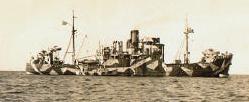Sperrbrecher

Sperrbrecher 131
|
|
| Class overview | |
|---|---|
| Operators: | Kriegsmarine |
| General characteristics | |
| Class and type: | Sperrbrecher 32 |
| Type: | Minesweeper |
| Displacement: | 7,500 tonnes (8,300 short tons) |
| Length: | 115.1 m (378 ft) |
| Beam: | 15.3 m (50 ft) |
| Draught: | 6.5 m (21 ft) |
| Propulsion: | One diesel engine, one shaft, 3,500 shp (2,600 kW) |
| Speed: | 14 knots (26 km/h) |
| Armament: |
|
| Notes: | Representative type of converted ships. |
A Sperrbrecher (German; informally translated as "pathfinder" but literally meaning "minefield breaker"), was a German auxiliary ship of the First World War and the Second World War that was intended to serve as a type of minesweeper, by sailing ahead of other vessels through minefields, intending to detonate any mines in their path. Also used as anti-aircraft ships, the Sperrbrecher suffered heavy losses in the war.
Sperrbrecher were used extensively by the Germans in World War I. The Imperial Fleet have a total of thirty Sperrbrecher for clearing mine streets - eight were lost during the war. Some of these ships were equipped with airplanes, such as Rio Negro, Plauen or Wigbert. In the World War II officially designated as 'Special Purpose Merchant Ships', although termed by the Royal Air Force as 'Heavy Flak Ships', the Sperrbrecher were converted from merchant ships for their special role, were primarily crewed by merchant seamen, and often had their cargo holds filled with buoyant material to aid in flotation in case of hitting a mine. The bows were also strengthened. Ships converted to the Sperrbrecher type were usually fitted with heavy anti-aircraft armament, and often carried barrage balloons.
The primary use of the Sperrbrecher was to escort other vessels through cleared paths in defensive minefields, for the purpose of detonating any mines that might have strayed into the passageways. In addition, the ships of the Sperrbrecher type would, early in the war, be used to clear suspected enemy minefields by simply sailing through them. Even with the strengthened hull and buoyant material, however, the ships suffered heavy losses in this role, and with the advent of acoustically and magnetically fused mines, this role became ineffective. Later in the war the Sperrbrecher type ships were used to escort U-boats in and out of harbour.
...
Wikipedia
